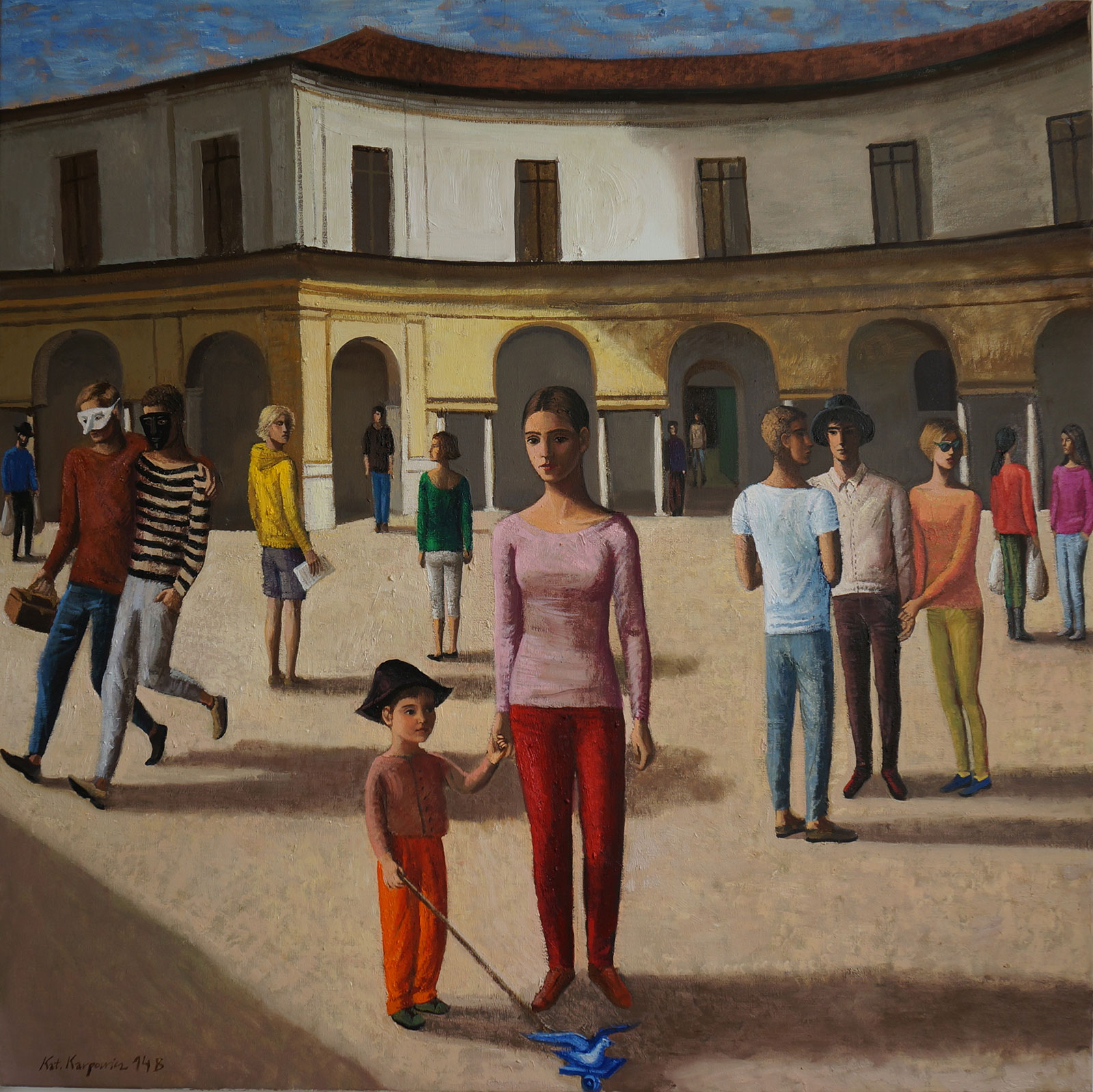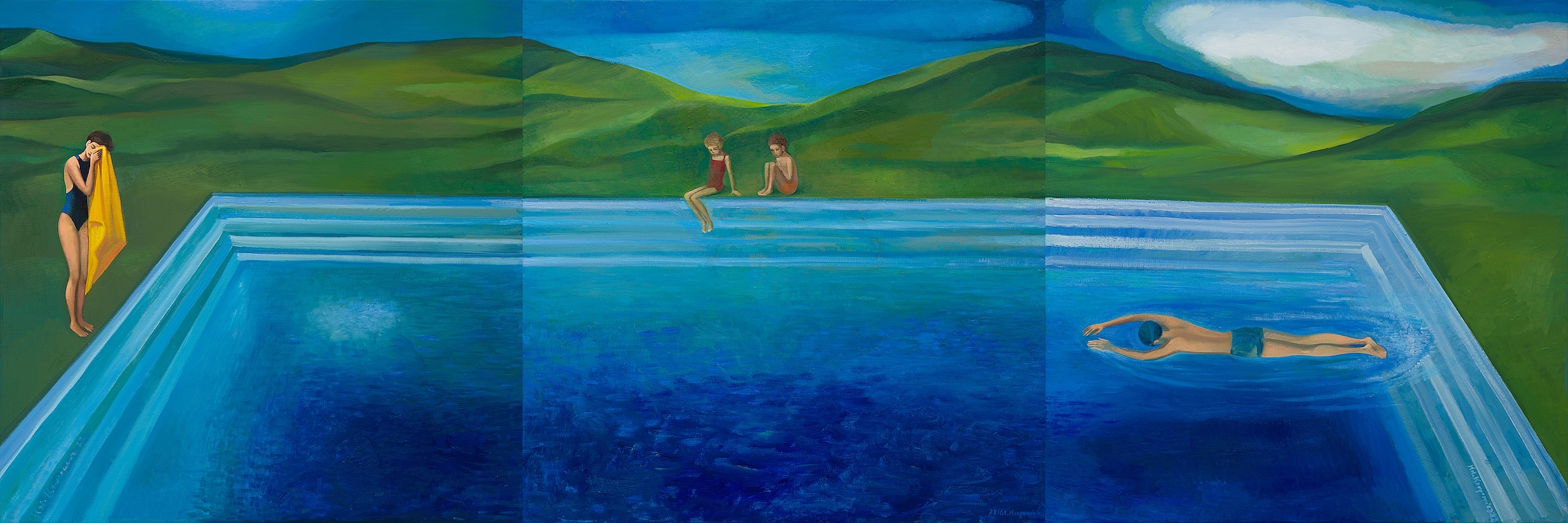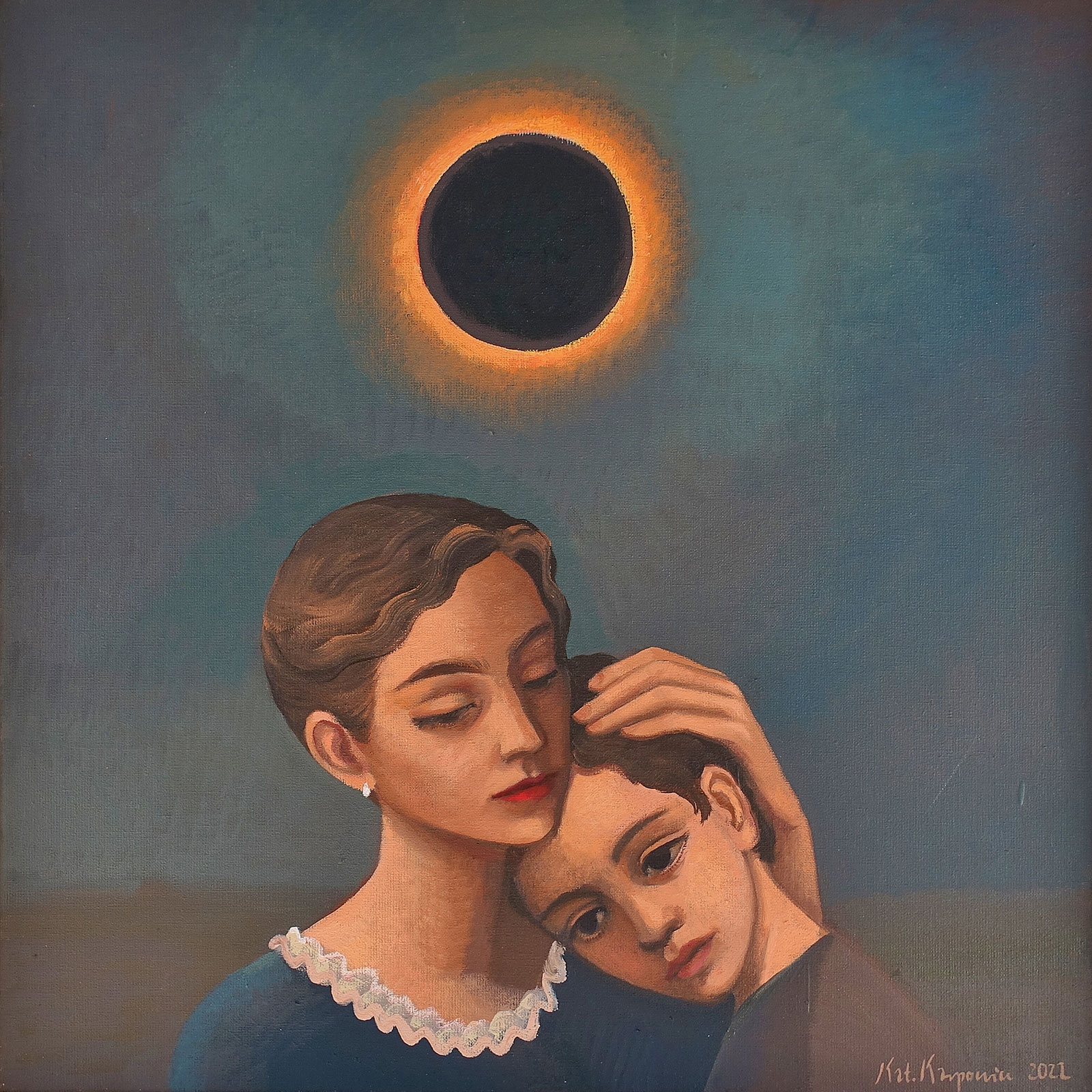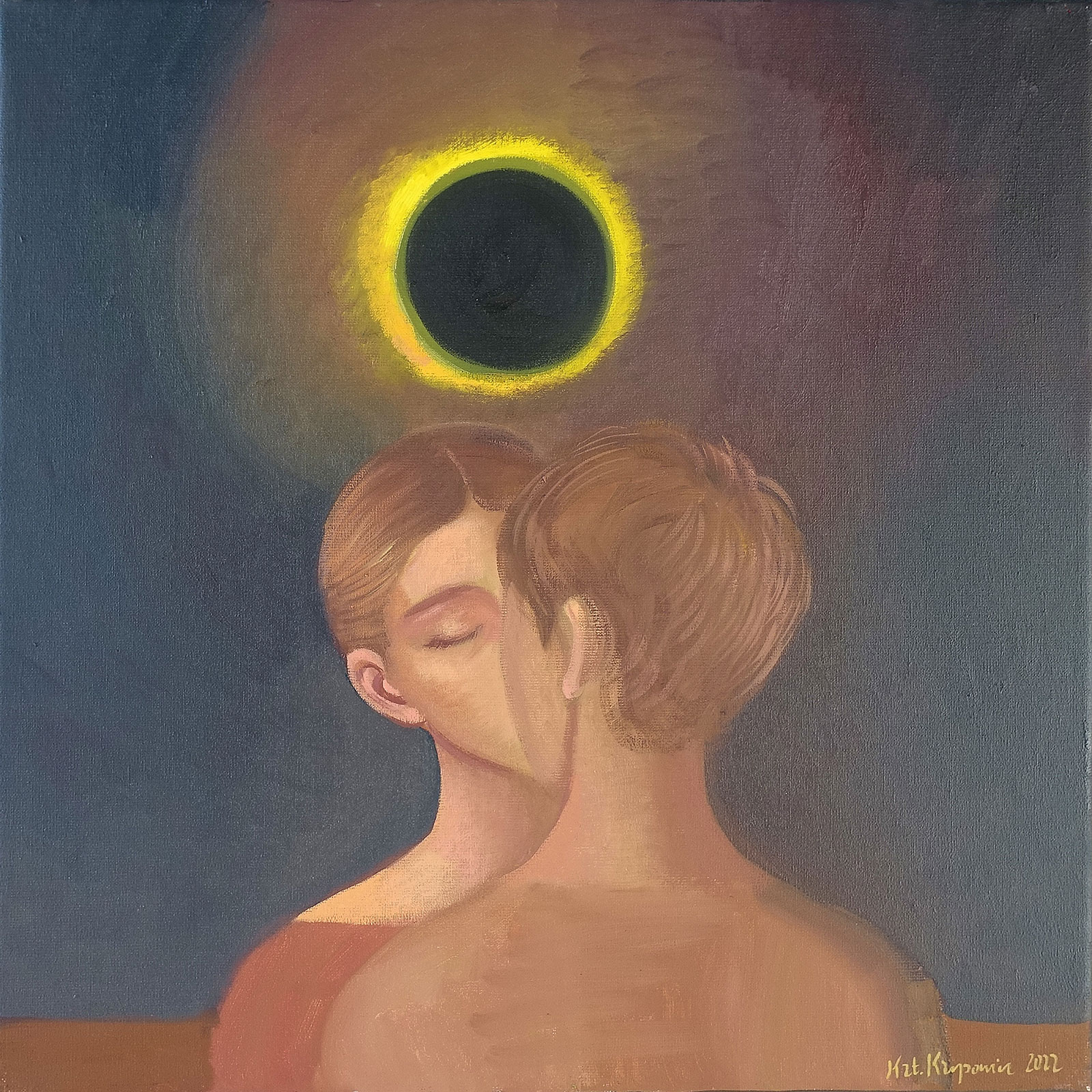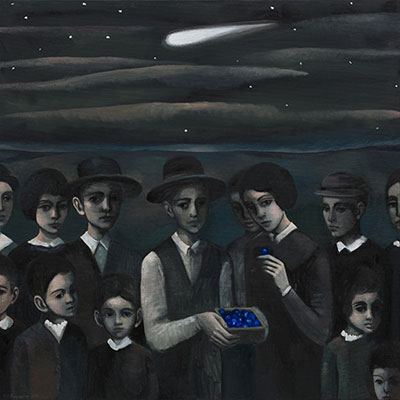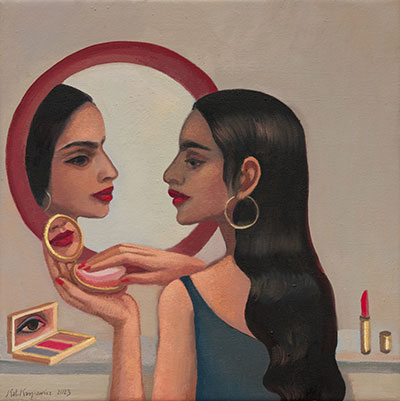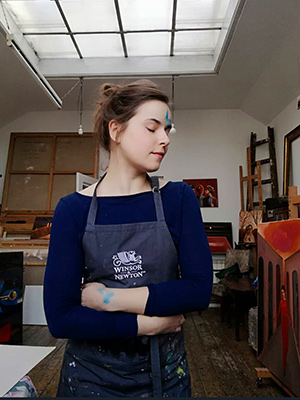Stop-frames of Sensitivity
Art is the enchanting of existence
to survive
but its space extends into the invisible
And is the intelligence that brings together clashing elements
with similarity
It is a brave thing
Because it seeks immortality
Being – like everything – mortal
I think I first saw Katarzyna Karpowicz’s paintings in 2015. A friend sent me a link to her portfolio at the time with an almost banal, standard question: ‘What do you think?’ If I remember correctly, I then stepped into the role of an academic lecturer and wrote him something about erudition and a staggering number of inspirations. In doing so, I automatically assumed that I was dealing with a mature artist, consciously playing with conventions. After all, students who have recently graduated from the Academy of Fine Arts do not have such a great orientation and ‘familiarity’ with world art.
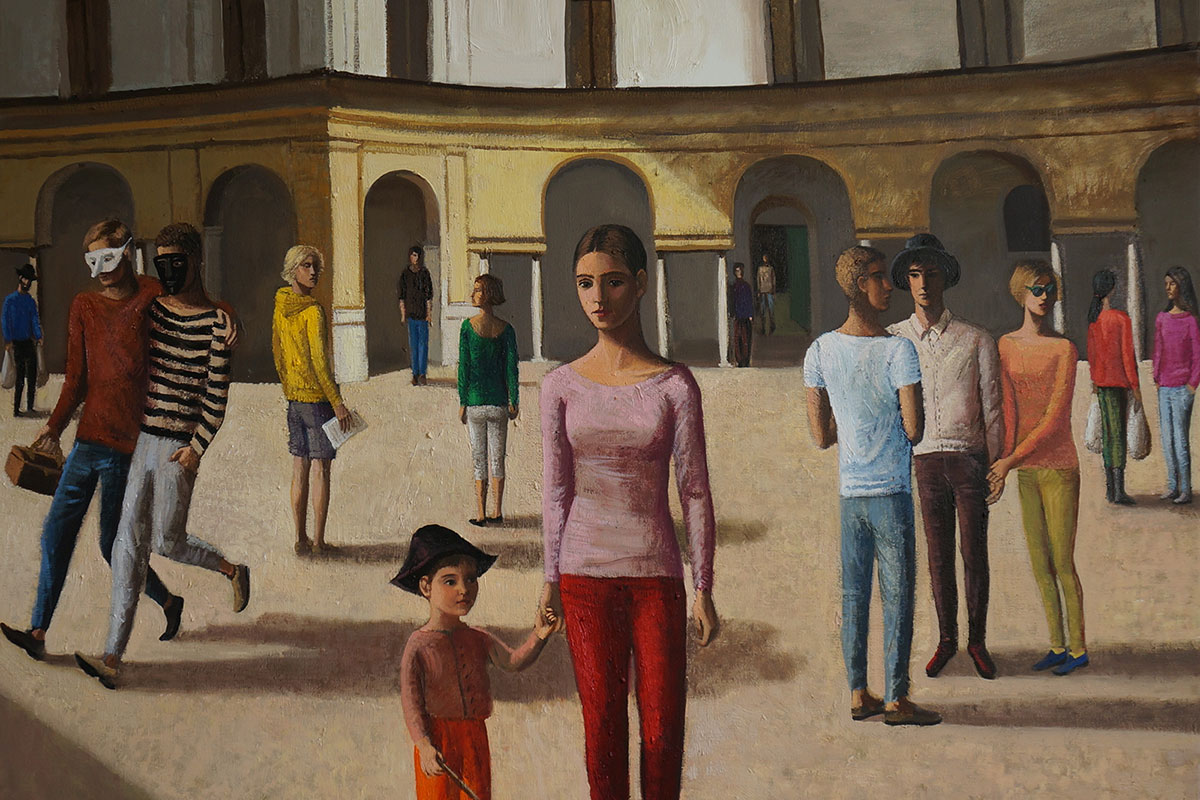
Her 2014 Mantua echoed Velázquez, the synthesis of architecture and space in the Piazza Castello was reminiscent of Chirico (except that here it was stripped of its unsettling loneliness), and I also saw there a child’s harlequin cap from Picasso’s Pink Period (or perhaps the one from Ślewiński’s Orphan of Poronin?), in the wooden bird I saw a distant reference to Goya’s portrait of Don Manuel, while in the Venetian mask I saw a reference to commedia dell’arte. I looked at this canvas and unobtrusive memories and free associations of paintings I had once seen constantly appeared before my eyes. As long as one has some knowledge of art, in a similar situation there is no turning back, one is drawn into an interpretive game. It was also a game of emotions: the artist created her images from her memories and experiences, while I wanted to relate them to my own experiences, and perhaps even establish some kind of understanding with her. To undertake a conversation in which not a single word is said.
It soon became apparent, however, that Katarzyna Karpowicz was a young painter just at the threshold of her career, and the explanation of these unbelievable artistic cryptic quotations lay in her biography: finding out whose daughter and sister she was, in what environment she grew up, in what flat she spent her childhood (in Olga Boznańska’s former studio in Krakow), who frequented it and who spoke there (in the 1980s and 1990s, almost everyone who mattered, the leading figures of Polish art and criticism). An artistic culture of this magnitude cannot be learnt by studying art history, it is simply learned lightly, naturally and almost involuntarily in the family home.
Since then, I have checked again and again to see what new work she has painted – and she has worked intensively. It is probably not without reason that she once took David Hockney’s words, ‘Inspiration never visits the lazy’, as her motto. I was curious as to who she was looking at at the time (I bet on Piero della Francesca, Frida Kahlo, Paula Modersohn-Becker, Ernst Ludwig Kirchner, Jerzy Nowosielski, Max Beckmann, her mother Anna Karpowicz-Westner. James Ensor, Giotto, Le Douanier Rousseau, Wassily Kandinsky, Kazimierz Mikulski – or perhaps Anna Güntner, Marc Chagall, Jean Dubuffet, Balthus…?) I wondered what she might be reading, what films were important to her. No, Karpowicz was by no means imitating or reinterpreting (this was never that level of reception and creation, after all) – she was an observer who painted her own intimate, artistic and intellectual (though subtle at the same time) diary, wrote an autobiography in the space of art with the trace of her brush.
I read two or three interviews she gave. I was pleased that she also liked Rilke’s poetry (I could feel it, after all, looking at her paintings!), that she mentioned some of the names that came to mind, and I learned about some personal, biographical keys and codes that could explain even the balancing act between death and life that is drawn in her paintings. And then I decided that I was done, I wasn’t going to do it anymore – because something else started to occupy me in her work. Not the tracing of inspiration, but the experiencing and ‘enchanting of existence’ that Julia Hartwig wrote about. I became curious about the sensitivity of the artist, a young woman I had never met in person. In 1967, Roland Barthes published the celebrated essay ‘La mort de l’auteur’ (‘The Death of the Author’). In it, he postulated that the writer is not the ‘father and mother’ or ‘owner’ of the texts, much less the guarantor of their interpretative correctness. I decided that I would also take this route, abandon academic temptations and simply let the ‘it is also this’ from the title of Hartwig’s poem play out exclusively between me and the images. After all, Marcel Proust wrote that a work with a theory inside it is like a present on which a price has been left.
I enjoyed watching her painting change. I suspect, moreover, that she will always be changing; she is hardly (and fortunately!) an artist who will one day settle down and develop ‘her own style’ – her gift for delight simply won’t allow it. If anything, it will continue to create its own styles and aesthetics. I noticed how, in the initially almost cubic syntheses of the figures, modelling began to emerge: softness, naturalness, subtlety tenderness and empathy. I was intrigued as to why, operating after all with excellent drawing and undoubtedly having a great technical background, she did not want to fully reveal his abilities. I was also struck by the fact that, almost from the outset, the artist expresses herself through thematic painting cycles in which, from painting to painting, she continues to add to and add to the meaning, as if she were in dialogue with herself.
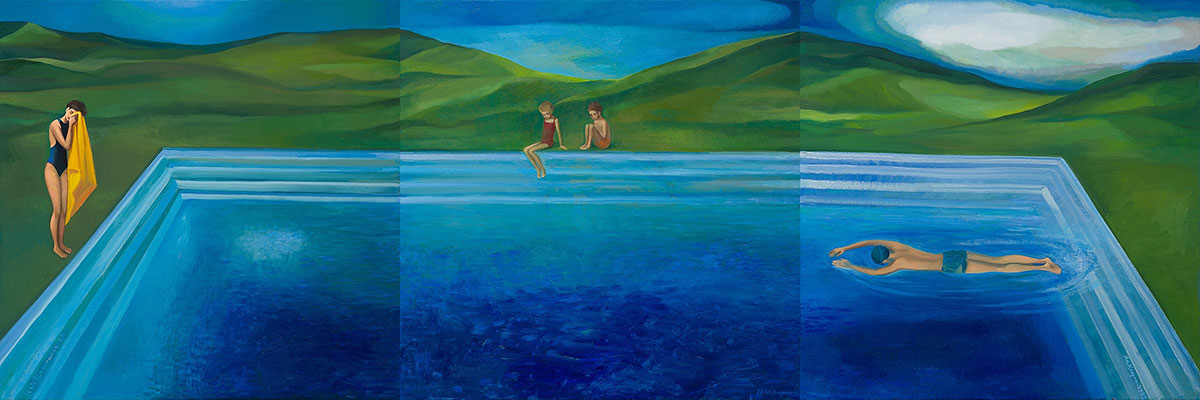
We see several such series in the Płock exhibition. In this entitled Pools. What a Holiday Should Look Like Karpowicz returns to a theme she has undertaken before, which critics have found to be inspired by David Hockney. But Hockney is there, after all, only in the subject matter and nothing else. The English artist’s predominantly flat blue surface is transformed into the depths and shifting hues of water charged with inner energy; the elongated, almost iconic silhouettes of levitating swimmers and their shadows are more reminiscent of the works of Jerzy Nowosielski. Katarzyna Karpowicz’s water appears to be an unreal and – here one would like to recall Bachelard – melancholic element.
The series Man Is Another Man’s Good seems to explore the various relationships between people, showing the empathy and security that the presence of another person gives, the feminine, almost feminist in spirit ‘sisterhood’, brotherhood and perhaps even love. The compassion and tenderness evident in the painting under the telling title Facing a Strange World, in which the painter depicted a pair of embracing boys and a mask cast aside against a sky and landscape escaping into abstraction, probably spoke to me the most. A sense of community is also suggested by the Four Seasons series. By accentuating the forms of tree branches in an intriguing way, the artist reinterprets an almost eternal painterly theme. Except that these images only resonate when put together and hung on one wall (let’s just hope all four make it to an aware connoisseur...). In contrast, the muted Streets, perhaps inspired by a Balthus canvas, showed something quite different. Balthusian eroticism and violence have been replaced by nostalgia, a sense of alienation and loneliness, all the more acute because experienced in the presence of people we know.
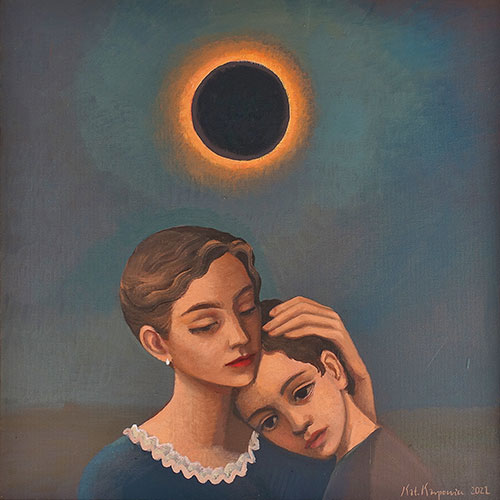
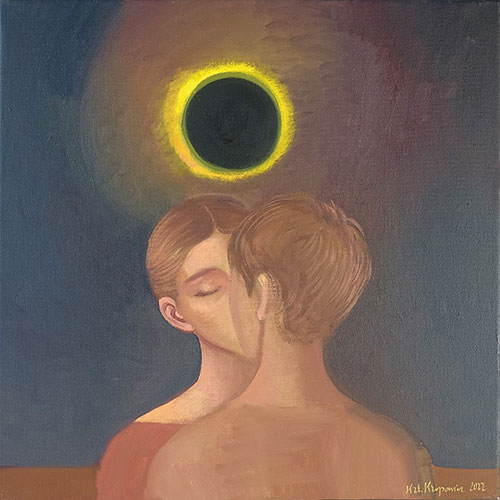
In Heavens and Strange Worlds I Escape To, I was struck in turn by the multicoloured areas of sky and clouds, transporting the viewer to a completely different dimension from the accompanying figures, conveying (as in Munch) emotion and de facto turning realism into abstraction. The sky and a dramatic solar eclipse are also seen in the Stories from Szczebrzeszyn series. Under an apocalyptic, ominous sky that spells doom, a black sun (an association with Julia Kristeva’s book on depression and melancholy emerges immediately), the artist places couples: Lea and Yaakov, Akiva and his mum, Chava and Chaim, Noah and Gittel, Perla and Saul and two singles, Chana and Tovah. Only it is not Szczebrzeszyn, where Sławomir Karpowicz, the artist’s father, painter and professor at the Academy of Fine Arts in Krakow, was born in 1952. It is a pre-war shtetl that its former Ashkenazi inhabitants called Shebreshin – שעברעשין.
In creating her intimate series, Katarzyna Karpowicz reveals to us successive stop-frames of her own sensitivity; she simultaneously reveals and does not reveal herself. She creates a self-sufficient and exhaustive language of art out of her personal experiences, probably also traumas (deconstructed, after all, by references), as if painting was breathing for her. There is not a hint of exhibitionism in this work, but a discretion of feeling and purity of emotion that is so rare nowadays. Paradoxically, I even began to wonder if the artist felt the need to talk to people face to face at all, rather than through paintings. And I guess, after years of looking at her work and writing the text for her catalogue, I’d like to finally find out, have a coffee with her in Krakow at last. ‘Tworzywo’ in Ghetto Heroes Square? ‘Pierwszy’ on Stolarska Street? ‘Prowincja’ on Bracka Street? Will you accept my tentative invitation?


